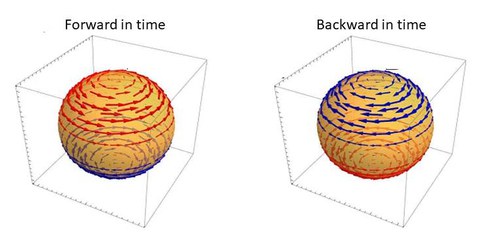Apr 19, 2021
Superconductors with “a spirit of time” – when materials differentiate between past and future

Magnetic fields inside a superconductor with broken time-reversal symmetry: Red and blue arrows illustrate the direction and strength of the internal magnetic fields for forward and backward time development. In case of an existing time-reversal symmetry the magnetic fields in the left and right figures have to be identical. This is only possible, if they are zero everywhere.
Physicists at the TU Dresden have discovered superconductivity with broken time-reversal symmetry in a class of iron-based materials. This exceptional property calls for new theoretical models and may become important in quantum computing. The research results are published this week in the scientific journal Nature Physics.
For men, what happened yesterday and what will happen tomorrow are two different and in general quite independent matters. Past and future of life are not symmetric and therefore also not reversible. In physics this is different. The fundamental forces of nature in elementary particles, atoms and molecules are symmetric with respect to their development in time: Forward and backward makes no difference, scientists call this a time-reversal symmetry.
For decades this symmetry was also found in all superconductors. Superconductors are materials which can conduct electrical currents at low temperatures without energy dissipation. One of their major applications are the efficient generation of strong magnetic fields, e.g. in magnetic resonance imaging (MRI) diagnosis. Approximately 99% of all known superconducting materials are „time-reversal symmetric“.
However, at the end of last century physicists discovered that some superconductors could brake time-reversal symmetry. To explain these observations, the basic mechanism of superconductivity, which is known for more than 75 years, had to be modified considerably. Only these new superconductors are able to spontaneously generate constant internal magnetic fields. This can lead to new applications, e.g. in quantum computing devices.
An international research team lead by Dr. Vadim Grinenko und Prof. Hans-Henning Klauss from the TU Dresden discovered entdeckte this new magnetic state with broken time-reversal symmetry in iron-based superconductors. The synthesis of this versatile class of intermetallic compounds is comparatively simple. Therefore these iron-based superconductors have a large potential for applications.
Original Publication:
V. Grinenko , R. Sarkar, K. Kihou, C. H. Lee, I. Morozov, S. Aswartham, B. Büchner, P. Chekhonin, W. Skrotzki, K. Nenkov, R. Hühne, K. Nielsch, S. -L. Drechsler, V. L. Vadimov, M. A. Silaev, P. A. Volkov, I. Eremin, H. Luetkens, and H.-H. Klauss, ‘Superconductivity with broken time-reversal symmetry inside a superconducting s-wave state’ Nature Physics, 10.1038/s41567-020-0886-9. URL: https://www.nature.com/articles/s41567-020-0886-9
